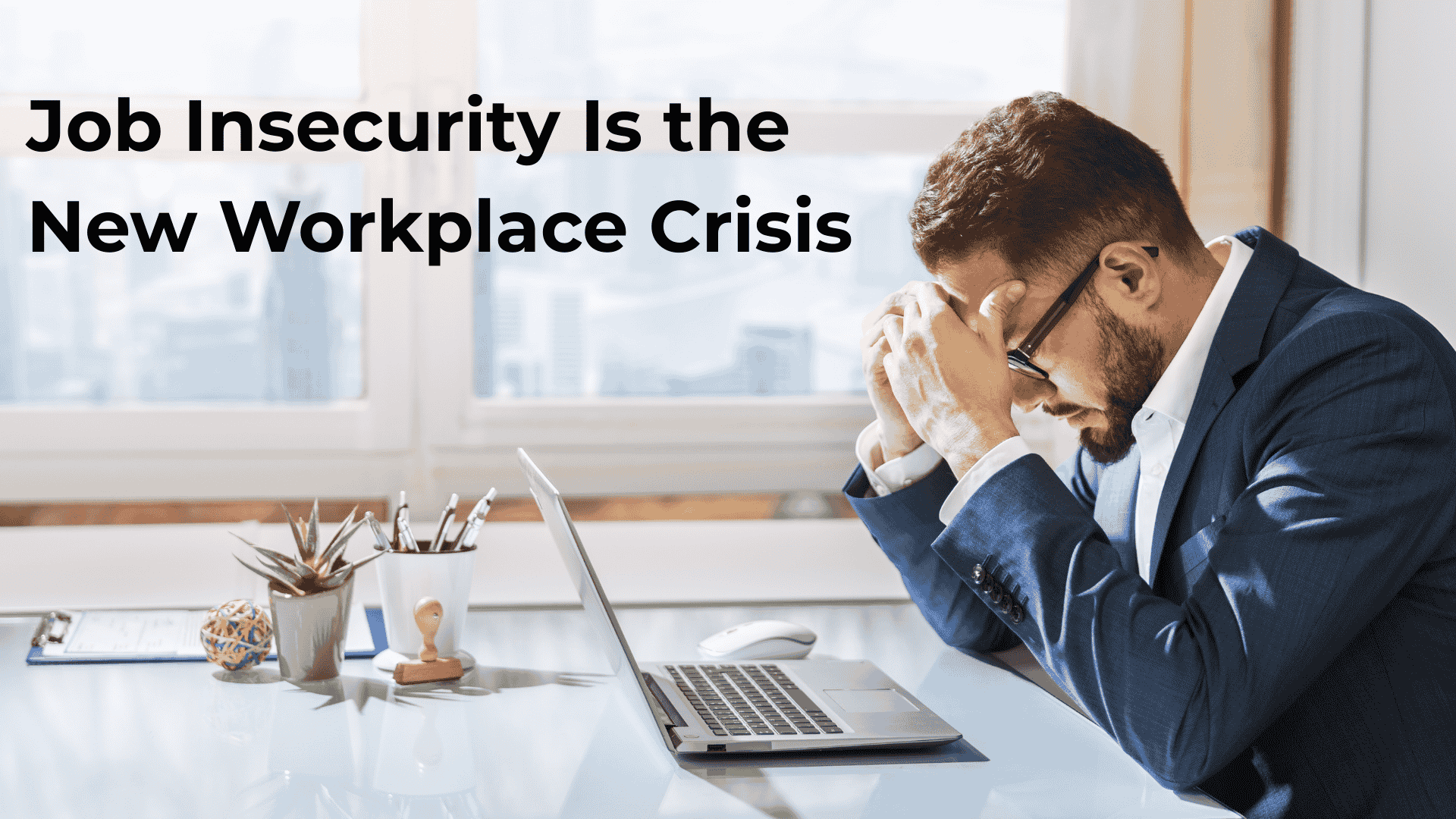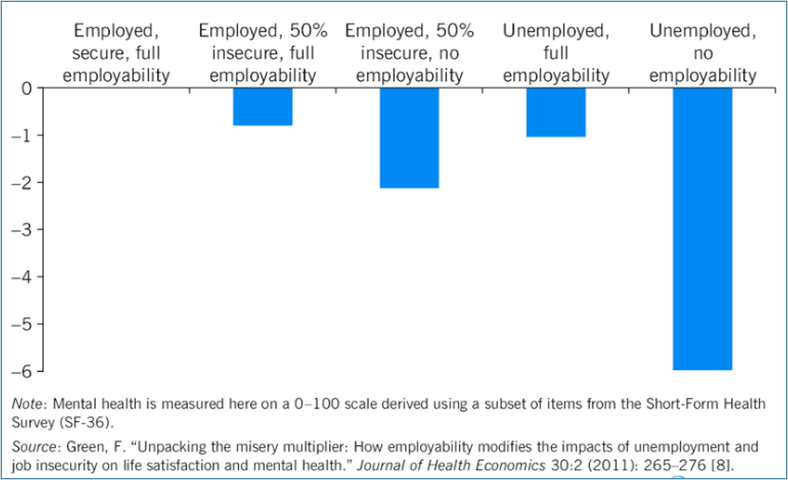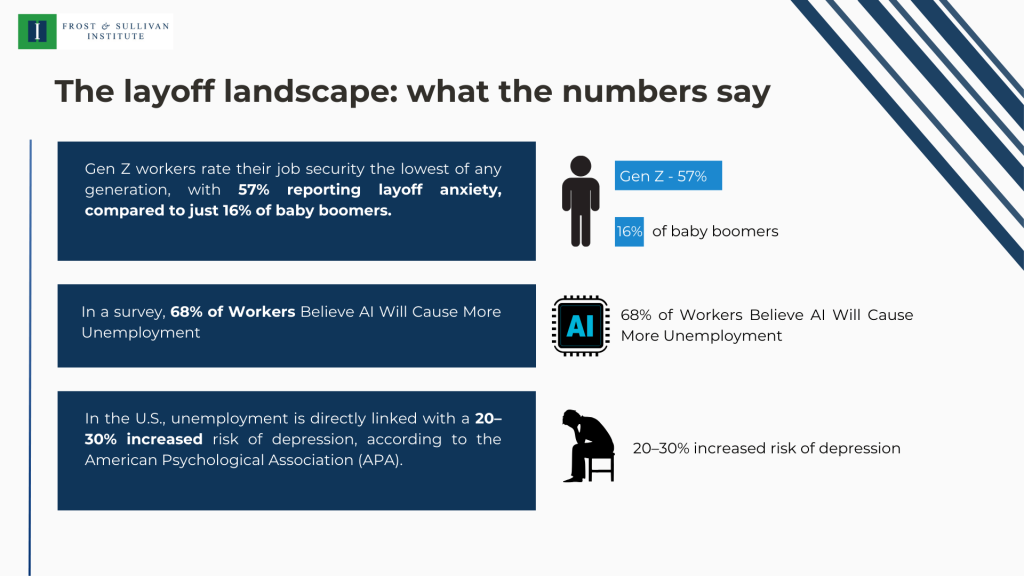
11 Jul How job insecurity is eroding employee mental wellbeing
In today’s rapidly shifting job market, job insecurity has become a quiet crisis, one that extends far beyond spreadsheets, pink slips, or severance packages. As layoffs surge across industries from big tech to government offices, the emotional toll on workers is intensifying. While job losses are often framed in economic terms, what’s overlooked is the devastating impact on mental health. For many employees, the fear of being next to go is a source of constant anxiety, and for those already affected, the aftermath can be emotionally crippling.
As of June 2024, companies had cut about 386,000 jobs in healthcare, IT, banking, and insurance sectors. This wave of job cuts has created a climate of uncertainty where no one feels safe. According to a recent study by Marketwatch, 70% of employees were bracing for layoffs in some way, with around 40% saving up for a possible layoff, and 32% reported that they regularly browse job listings.
Job insecurity is not just an economic issue; it’s a public health one. Every layoff is more than a number; it’s a life disrupted. And unless institutions, policymakers, and leaders respond with empathy and action, we risk allowing the quiet trauma of job loss to escalate into a full-blown mental health epidemic. It is time to act now, not just for the sake of productivity, but for the well-being and dignity of every worker.
Effect of Insecurity and Unemployment on Women’s Health in Australia

The image illustrates the impact of job insecurity and unemployment on women’s mental health in Australia, highlighting the critical role of both employment status and perceived employability. Mental health scores, based on the SF-36 survey, decline as job security and employability decrease. Women who are employed and feel secure show the highest mental wellbeing, but even a 50% reduction in job security significantly lowers mental health, more so when accompanied by low employability. Unemployed women with low employability report the steepest decline in mental health, demonstrating that lacking both a job and the confidence to obtain one severely harms psychological well-being. This visual evidence underscores how job insecurity, not just unemployment, can erode employee mental well-being, revealing that the perception of future employment prospects (employability) serves as a protective buffer. As such, organizations and policymakers must address not only employment quantity but also the quality and security of jobs to safeguard mental health.

- Unemployment as economic trauma: A hidden mental health epidemic
A job isn’t just about income; it’s about identity, stability, and control. When people are unemployed, it often triggers a chain of emotional reactions like grief, including denial, anger, depression, and even shame. Psychologists are now using the term economic trauma to describe this cluster of mental health impacts stemming from financial loss.
A study from the University of Cambridge found that laid-off individuals were twice as likely to experience clinical levels of anxiety and depression six months after losing their job, compared to those who retained employment. - More than one victim: The household ripple effect
The emotional effect of unemployment rarely ends with the individual. In many households, especially in regions like South Asia, Latin America, or Africa, one job often supports an entire family. According to UN Women, during the pandemic, women experienced more distress from layoffs due to their dual roles in income generation and caregiving. Children in households facing long-term unemployment show higher rates of anxiety and lower academic performance, as per a Journal of Child Psychology and Psychiatry review.
In essence, a single layoff becomes a mental health crisis for an entire household, particularly when savings are minimal and alternative income sources are scarce.
- The psychological cost of “AI layoffs” and automation
The rise of artificial intelligence is fueling another emotional undercurrent: existential dread. Unlike layoffs from market downturns, AI-driven job losses strip people of the belief that their skills are still valuable in the modern world, making recovery emotionally harder.
In interviews conducted by Harvard Business Review, many displaced tech professionals described feeling “obsolete”, a devastating emotional blow in a society where productivity often defines self-worth. A 2022 Mind Share Partners report found that 60% of workers did not speak to anyone about their mental health after being laid off, primarily due to stigma and fear of being perceived as weak.
What is being done to address this brewing mental health crisis?
- In the UK, the National Health Service (NHS) has launched an integrated mental health and employment program, which has already supported over 100,000 individuals by combining job coaching with psychological therapy. Launched nationwide in 2022, backed by £122 million in government funding, as of the 2024–2025 period, around 70,000 people have accessed employment support via the program, marking a 62% increase year-over-year.
- The United States, through the National Institute for Occupational Safety and Health (NIOSH), has been promoting the total worker health framework, an initiative that integrates workplace safety with mental well-being support. Some progressive companies are also taking steps. IBM, for instance, now offers resilience workshops for employees facing uncertainty, and firms like AEP are providing outplacement services, career counseling, and access to mental health professionals.
- Germany’s “kurzarbeit” program, which subsidizes wages to avoid layoffs, has been credited with reducing both unemployment and mental health issues during economic downturns. It’s a government-subsidized scheme where companies reduce employees’ working hours instead of laying them off, and the government compensates a significant portion of the wages lost. A 2020 study published in the Journal of Health Economics found that Kurzarbeit helped mitigate psychological distress caused by job insecurity and income loss during the COVID-19 pandemic.
- Layoff-specific peer-support groups have emerged organically on platforms like Reddit, Discord, LinkedIn, and Substack. For example, Business Insider reports groups such as “the labor club” (for women laid off while pregnant) and niche layoff communities.
Still, these efforts remain uneven and insufficient. In many workplaces, layoffs are handled with cold efficiency, with little thought given to the emotional repercussions. Clear, honest communication from leadership during downsizing can ease the trauma, but many companies still rely on opaque emails or unexpected Zoom calls that leave employees feeling blindsided and disposable.
Time to stop treating layoffs as just economics
The real cost of layoffs cannot be calculated in dollars saved. It’s in the sleepless nights, the panic attacks, the broken routines, and the identities questioned. As layoffs become more frequent in an unstable world, we must reframe them not just as financial or logistical challenges but as emotional events with the power to scar. Economic trauma is real. And until we address the mental health crisis behind the employment crisis, we’re only solving half the problem.
Blog by Shreya Ghimire,
Research Analyst, Frost & Sullivan Institute
